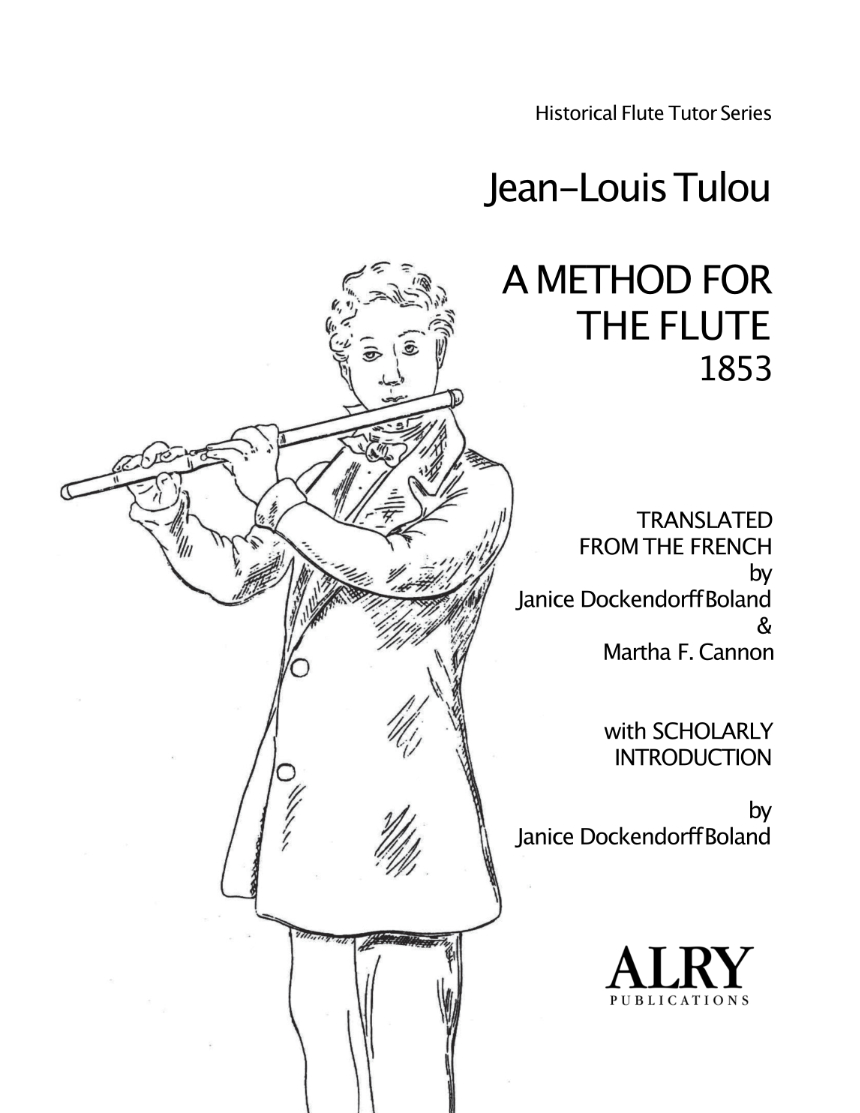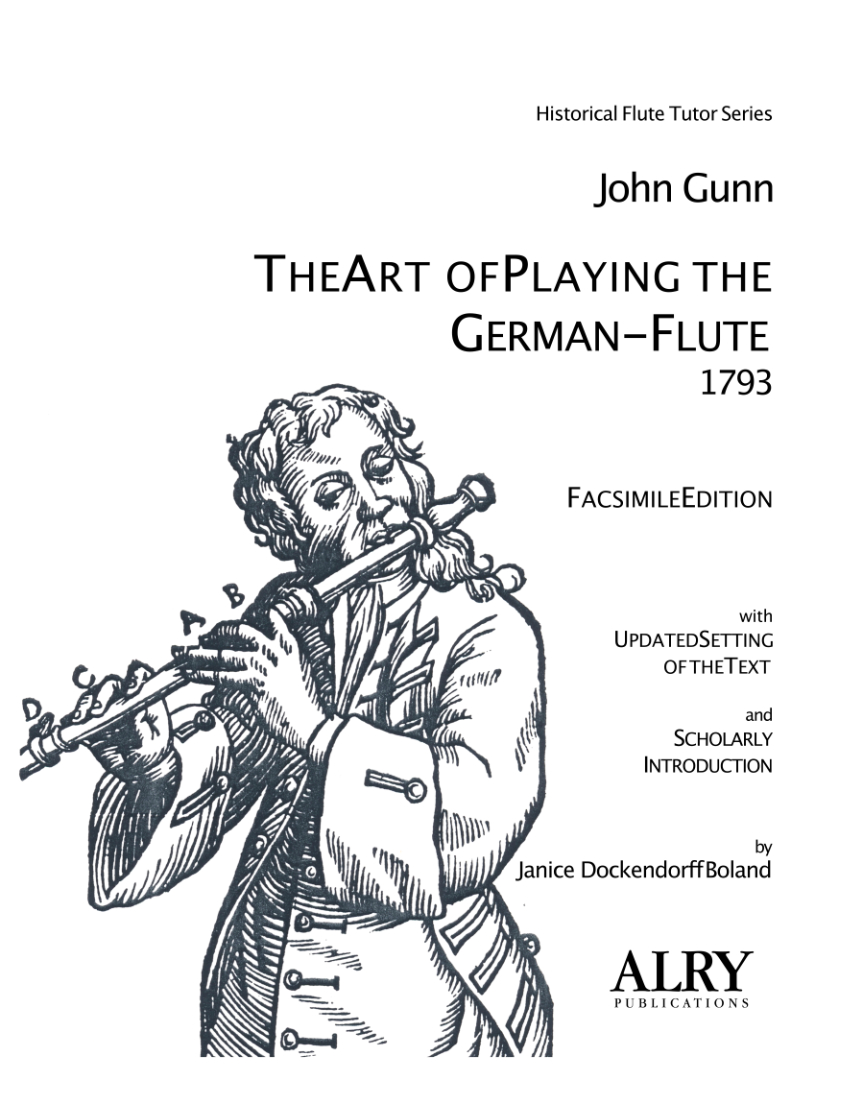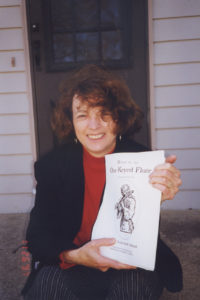Boland / Tulou / Gunn / Drouet / Heron
Method Books for Flute
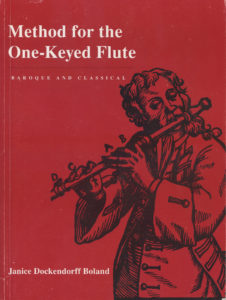 Method for the One-Keyed Flute
Method for the One-Keyed Flute
(baroque & classical)
by Janice Dockendorff Boland
University of California Press, 1998
Japanese translation: Vorn Musik Atelier, 2017
Portuguese translation by Lucas Caetano, 2023
Available from: University of California Press
Japanese translation available from: Vorn Musik Atelier
Named a Winner Newly Published Music Competition
National Flute Association, 1999
An indispensable manual for present-day players of the eighteenth-century flute, Method for the One-Keyed Flute is the first complete method written in modern times. Janice Dockendorff Boland has compiled a manual that can serve as a self-guiding tutor or as a text for a student working with a teacher. Referencing important eighteenth-century treatises while also incorporating modern experience, she guides the reader through historical music with ease and grace. The book includes nearly one hundred pages of music drawn from early treatises, along with solo flute literature and instructional texts and fingering charts. Boland also addresses topics ranging from the basics of choosing a flute and assembling it to more advanced concepts such as tone color and eighteenth-century articulation patterns. Beginning students and experienced will find a wealth of material in Method for the One-Keyed Flute.
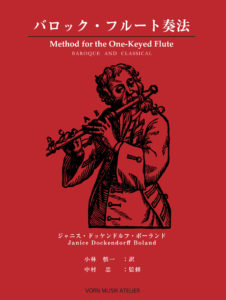 from Laurence Libin, Metropolitan Museum of Art
from Laurence Libin, Metropolitan Museum of Art
“Janice Boland’s clear, accessible text reflects years of professional experience as a performer and teacher of the one-keyed flute. Her book answers all the practical needs of beginners and offers advanced flutists a wealth of useful information drawn from historical sources. Even players wedded to the Boehm flute will gain fresh musical insights from Boland’s comprehensive method.”
from Christopher Krueger, New England Conservatory & Oberlin Baroque Performance Institute
“Jan Boland has written an invaluable resource for students of the baroque flute as well as for any flutist interested in performance practices of the eighteenth century. This book provides a wealth of well-interpreted historical information and excellent practical advice to guide flutists through the confusions and contradictions of this fascinating field.”
from John Thow, University of California Berkeley
“This is the best introduction to the one-keyed (baroque) flute for Boehm-system flute players available today. I only wish it had been available when I set out to learn the one-keyed flute. It would have saved me much time and led me directly to the most important sources.”
from Betty Bang Mather, Professor Emeritus, University of Iowa
“An easy-to-read format, clear prose, attractive graphics, and well-chosen music make it an ideal beginner’s tutor.”
from Stephen Preston, London, Guildhall and Royal College of Music.
“…an invaluable new resource for all flute players and teachers who would like to increase their practical understanding of the eighteenth-century one-keyed flute. Dr. Boland’s knowledge, experience, and respect for authentic performance shows in every page of this book in her use of original source material, her explanatory comments, and in the appendices and bibliographies. I shall certainly enjoy using the Method for teaching and warmly recommend it to all students and colleagues.”
Reviews of Method for the One-Keyed Flute
“It’s finally here. This method takes historically informed performance to a new level. Boland has incorporated the best of the early masters and improved on them and made their work accessible to modern players. Over time this modern method surely will take its place in flute history alongside those distinguished predecessors.” Jerry E. Pritchard, The Flute Network
“It would be fair to suggest that this falls into the ‘all the information about the baroque flute you were too afraid to ask’ category. A clearly laid out and informative manual. A valuable tool for performers and researchers alike. I am sure teachers and students will breathe a huge sigh of relief at the wealth of information gathered together in one volume.” Marie Ritter, Early Music Review
“A new, innovative, and practical resource for baroque flute performers and teachers. Clear and concise… This practical and valuable method should be considered an essential addition to the library of every flutist who has even a passing interest in the one-keyed flute.” Hal Ott, Flute Talk
“Even though the book is meant as a practical guide, its comprehensive scope is impressive. Ms. Boland has managed to touch on almost all aspects of playing the one-keyed flute. …I would highly recommend the book to any Boehm-system flute player who wants to explore the one-keyed flute. It is also an excellent tool for teachers, and a handy reference book for the advanced player.” Na-ama Lion, Continuo
“…provides a much-needed overview of the instrument while introducing some of the many aspects of performance practice that a newcomer will be obliged to tackle. As such, her work is extremely welcome and will be enthusiastically received by many players.” Christine Garratt, Early Music
“Check out Boland’s book, Method for the One-keyed Flute, a must-have for every player interested in early flute music. Of particular interest are her comments on tone production and homogeneity of sound.” Ann Cherry, Pan, The Flute Magazine (June 2006)
“A near-perfect historical instrument method. Wonderful book. Excellent exercises and full of history. I’m not an expert in traverso, but the fingering chart is very complete and ideal for who want to learn by yourself.” Spyware Reader’s Review (on-line source)
“It is easy to see why this Method is warmly endorsed by early music specialists Stephen Preston and Betty Bang Mather. Janice Boland’s Method is an excellent reference book.” Ann Cherry, Music Teacher (January 2001)
“This is one of the best method books I’ve seen for a historical instrument. Every essential topic is covered: tuning, intonation, articulation, fingering, baroque & classical ornamentation (fingering for trills off of each note, for instance). Period sources (notably Quantz, plus several others) are quoted frequently. There is also a good discussion on the differences between different historical models. Plus there is a wealth of exercises and tunes from the period. While not pretending to be complete in every sense, this is far superior to many methods I’ve seen for recorder and other instruments. It’s also quite affordable. Jan has written a clear, concise yet very complete book.” Spyware Reader’s Review (on-line source)
“The book has great instruction at your fingertips to start learning the one-keyed flute. There is so much here! But it’s not bogged down with copious trivia. This book is especially helpful for the Boehm flutist who wishes to transition into some baroque flute playing. When you purchase this volume, you’ll have everything you need (apart from the instrument itself!) to get started, and also to avoid injury to your hands and fingers through incorrect position or over-practicing. Wonderful, sound advice clearly presented.” Spyware Reader’s Review (on-line source)
A Method for the Flute – 1853
by Jean-Louis Tulou
English translation by Janice Dockendorff Boland
and Martha F Cannon. With updated introduction 2025.
Availability: ALRY Publications, 2025
Jean-Louis Tulou (1786–1865) was a renowned 19th-century French flutist and composer, known for his expressive playing. Tulou was Professor of Flute at the Paris Conservatoire for more than two decades, during which time he wrote Méthode de Flûte (1853). He prioritized a vocal-like tone over technical showmanship, aiming to evoke a response of ‘how charming” rather than “how astonishing.” Tulou opposed the newer Boehm flute, which he felt lacked the flute’s characteristic charm. His tutor introduces fingerings for nuanced playing, and highlights differences between French and English performance practices. It includes 32 pages of musically satisfying Progressive Etudes. This English translation of the 1853 edition by Janice Dockendorff Boland and Martha Cannon includes a scholarly introduction by Boland, placing Tulou’s work in the context of earlier flute tutors.
Reviews of Tulou’s Method
. . . with a critical introduction by Jan Boland. The instructions, exercises, playing material, duets, solos, illustrations, examples of embellishment and interpretive style make this a valuable book for all players wishing to learn or explore the early 19th century literature. In addition to variations on famous opera themes, Tulou provides wonderful original etudes in the grand and expressive style of his famous fantaies and solos. Each of the musical works has a duet part so the teacher can accompany the student with steady rhythm, good pitch, and interpretive guidance. Fingering and trill charts are provided for flutes of up to 13 keys. The progressive the thoughtful organization of this method make it useful to teachers of any model of transverse flute — useful even with beginning students. Jerry E. Pritchard, Flute Network.
The Art of Playing the German Flute – 1793
by John Gunn
A new facsimile edition
with introduction and updated setting of the text by
Janice Dockendorff Boland
Availability: ALRY Publications, 2025
Gunn’s The Art of Playing the German-Flute, 1793, edited by Janice Dockendorff Boland, is the most comprehensive flute tutor to emerge in England during the eighteenth century. Gunn, a respected Scottish flutist and teacher, offers detailed and scholarly instruction on fingering for one-keyed and six-keyed flutes, tonguing techniques, ornamentation, practice methods, and musical expression. His practical, scientific approach to tone production is especially noteworthy and remains useful for today’s flutists. The tutor reflects the transition in flute playing from the late 18th to early 19th century, making it relevant for both historical and contemporary flutists. The tutor includes traditional Scotch airs and solos in Theme and Variations form.
This edition is printed with a updated setting of the text. The original facsimile is written in Old English; and the text distinguishes between the hard “s” and the soft “s” with the use of the medial S which resembles a modern “f”. For example, the word “suppose” appears as “fuppofe”. This edition presents a retyped version of the text to improve its readability.
Reviews of Gunn’s The Art
“Gunn’s treatise is special because, as Boland points out in her notes, he is one of the first to approach principles of flute technique from a scientific point of view. Boland’s introduction helpfully sets Gunn and his ideas in context.” Scott Patterson, Continuo
“This is a great source of information and playing material for intermediate to advanced students of the baroque flute. Reprint begins with extensive and charming introduction on flute playing.” Jerry E. Pritchard, The Flute Network
“I think every flutist should have a copy of Gunn’s tutor, an unjustly neglected masterpiece, at any price. It’s not the usual parroting of Hotteterre and Quantz, but a conspicuous original work that discusses acoustics, musical metre, harmony, figured bass, harmonics, and the ‘Method and proper Objects of Practice’. The studies at the end of the volume are extremely interesting and useful, and unlike the French ones of the same period, designed for grownups rather than children. Because Gunn was not Quantz or Devienne, his tutor is almost completely unknown.” Ardal Powell, Early Flute List
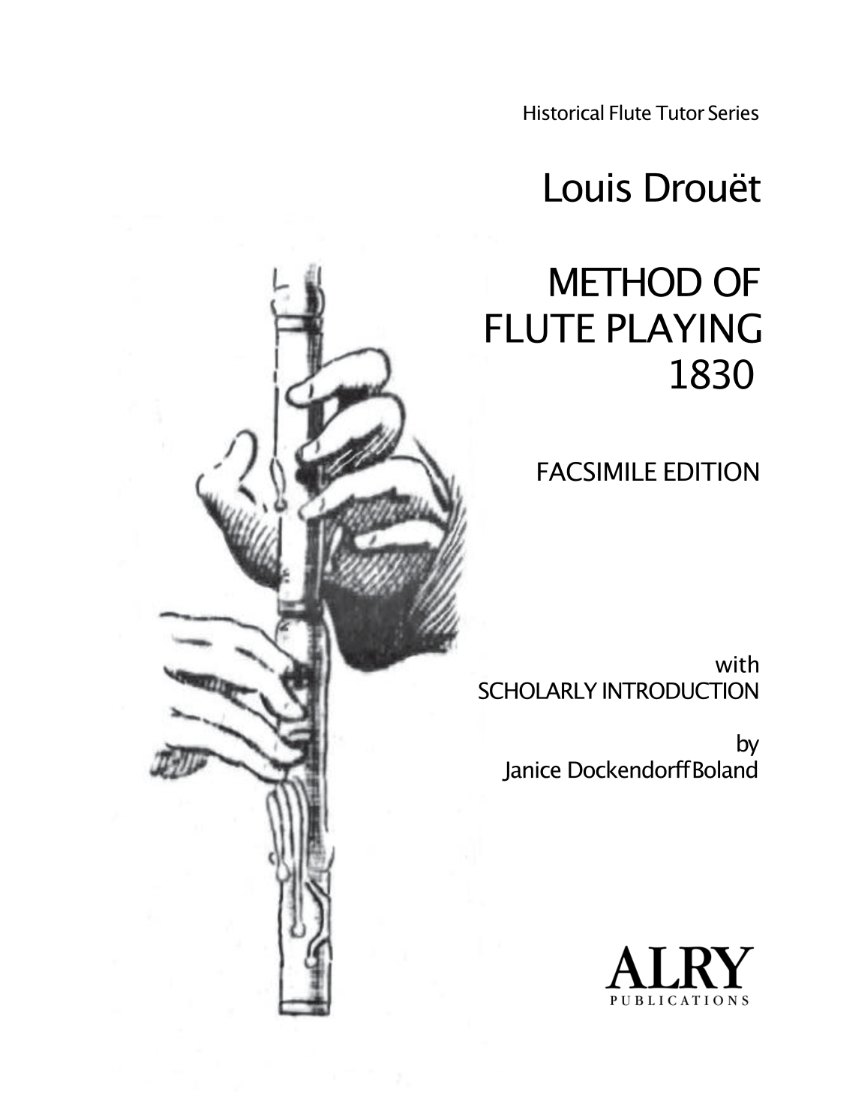 Method of Flute Playing – 1830
Method of Flute Playing – 1830
by Louis Drouët
A facsimile edition with introduction and notes
by Janice Dockendorff Boland.
Availability: ALRY Publications, 2025
Reowned flutist, Louis Drouët, wrote his 1830 Method of Flute Playing for players of the eight-keyed flute. Drouët, born in 1792, was celebrated for his technical skill, and gained prominence in the musical scenes of France and England in the early nineteenth century. Drouët’s Method, published in English, provides essential guidance on eight-keyed fingerings, illustrated not only with charts but also notably within musical passages. His tutor gives a unique insight to breathing, and a critique of contemporary techniques – addressing tone, ornamentation, and articulation. The satisfying music is helpfully riddled with fingering suggestions.
Reviews of Drouet’s Method
“This reprint is an excellent edition which includes a modern preface…designed for those learning to play the 8-keyed flute. This reprint is an excellent edition which includes a modern preface. Drouet’s method is very practical, with valuable advice on fingering choices, solfeggio, principles of harmony, articulation and style. Many duets and sonatas are included which are suitable for either study or performance.” Jerry E. Pritchard, The Flute Network
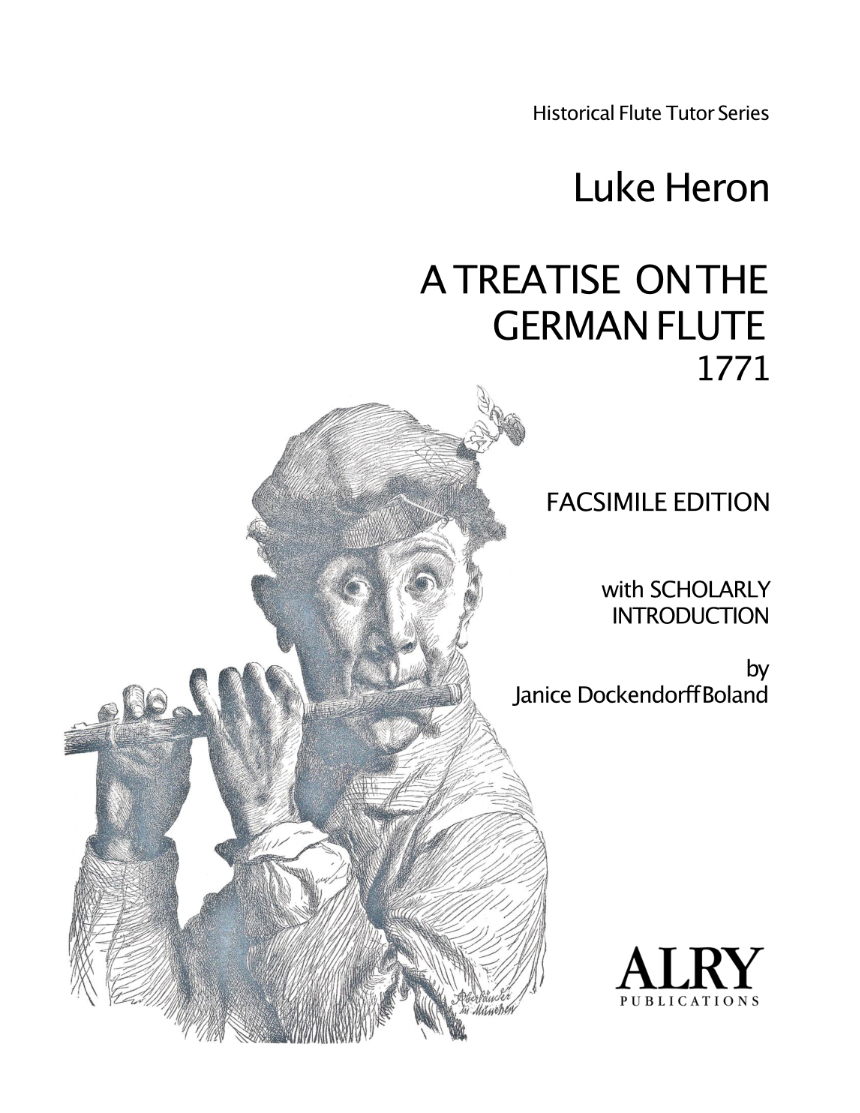 A Treatise on the German Flute – 1771
A Treatise on the German Flute – 1771
by Luke Heron.
A facsimile edition with introduction and notes
by Janice Dockendorff Boland.
Availability: ALRY Publications, 2025
Irish scholar Luke Heron’s A Treatise on the German Flute, 1771, is the first comprehensive English-language guide for the one-keyed flute. This rare tutor diverges from prior little English instructional books by emphasizing musicality and sensitivity, influenced by ancient Greek views on music’s power to regulate passions. The tutor covers tone, breathing, intonation, ornamentation, and articulation, but Heron stresses that these important technical details serve the broader purpose of musical expression. Heron’s emphasis on character and passion in flute playing echoes his view that music is the “language of the soul.” Includes 27 pages of music. This 2025 edition, edited Janice Dockendorff Boland, is the first facsimile of his work.
Reviews of Heron’s Treatise

